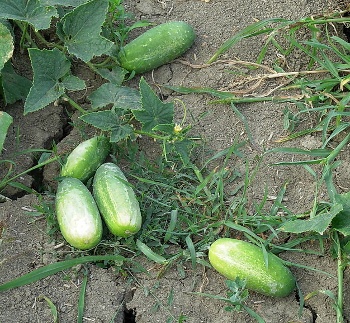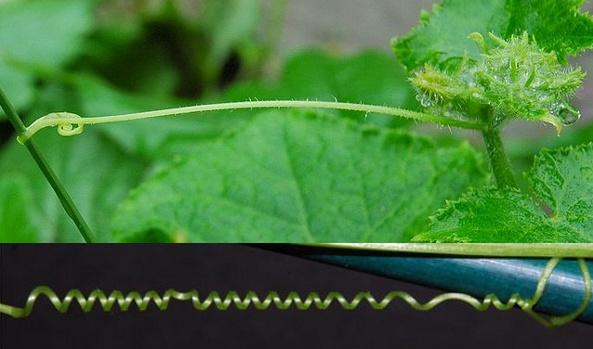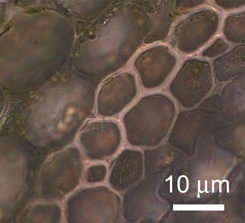Twisty Cucumbers, All Alike
September 7, 2012
As if
gardening isn't hard enough, a home gardener needs to know
genetics; well, at least the
folklore version of genetics passed from one
generation of gardeners to another.
Summer squash, including
zucchini, is a member of the
Cucurbita pepo species, of which
pumpkins and
gourds are also members. This means that there's a possibility of
cross-pollination between these plants.
This is no real problem in any single year, but
seeds saved to the next year may not give you what you expect. To prevent problems, distances of a
kilometer or greater are advised between extensive planting of different species. Folk knowledge is not perfect, since it's often thought that
cucumbers and squash will cross-pollinate. They don't.

(Photograph by Piotr Konieczny, cropped, from Wikimedia Commons)
One thing that cucumbers and squash have in common is their
tendrils, those plant runners that attach to objects to elevate the
leaves to regions with more
sunlight (see photograph, below). Since plant fibers do not contract as well as
animal muscle, the way that these tendrils draw the plants upwards is by forming a
spiral/
helical structure. The overall structure, however, is unusual.
The tendrils form a
right hand helix on one end, and a
left hand helix on the other. This was noted by
Charles Darwin in 1865. As a result of this structuring, there's a transitional region in the center of the tendril that Darwin called a "perversion." it's a strange use of the word, today, but "perversion" actually derives from the
Latin adjective, "perversus," which means slanted, crooked, or cross-eyed.

Tendrils of the cucumber plant, Cucumis sativus. In the top image, the tendril has just grasped an object and it hasn't formed the dual helix structure. The dual helix structure is shown in the lower image. (Top image by Kropsoq, via Wikimedia Commons). Lower image, Harvard SEAS image by Joshua Puzey and Sharon Gerbode).[1)]
An
interdisciplinary team of
scientists associated with
Harvard University's School of Engineering and Applied Sciences, the
Wyss Institute for Biologically Inspired Engineering, the
Department of Organismic and Evolutionary Biology, and the
Department of Physics, has just published a study of the coiling of cucumber tendrils.[1-3] The
biological mechanism for this coiling had been a mystery.[1] The research team, led by
L. Mahadevan, the Lola England de Valpine Professor of Applied Mathematics at
the Harvard School of Engineering and Applied Sciences, also developed a mechanical analog that exhibits the coiling properties of these tendrils.[1]
A mechanical analog of the cucumber tendril would be useful. It's a soft
spring when gently pulled, but it's a stiff spring when it's pulled hard. When
stressed, the cucumber tendril doesn't unwind into a flat ribbon; rather, it coils further. Says
Sharon Gerbode, lead author of the study who is now a member of the
physics department at
Harvey Mudd College, "What's strange about the cucumber tendril is that if you pull on the ends, it actually over-winds, adding more turns to both helices."[SEAS]
Examination of the tendrils at the
cellular level revealed that a fibrous
ribbon, composed of thread-like
gelatinous fiber cells just two cells thick, runs the length of the tendril. Once you have such a structure, contraction on one side will cause it to curve and coil.

Cells in a cucumber tendril's core fiber. The thick cell walls containing lignin, are visible.
(Harvard SEAS image by Joshua Puzey and Sharon Gerbode).[1)]
Gerode and coauthor
Joshua Puzey decided to mimic this mechanical structure using
silicone. Gluing a fabric ribbon to one side of a silicone ribbon and a
copper wire to the other side gave the same dual helix structure as a cucumber tendril. The key to the design is that the
bending stiffness of the ribbon is higher than the twisting stiffness, so it's easier to axially twist the ribbon than to bend it.[1]
Nature, of course, discovered this trick through
natural selection, and it confers an
evolutionary advantage to tendril-forming plants. As Mahadevan summarizes,
"The advantage of using a tendril is that the plant saves on complex machinery to build structural supports such as trunks and branches. The disadvantage is that it must depend on other species to build these supports. Thus, tendrils are an adaptation that is likely to develop only in regions replete with vegetation that can provide supports and where competition for resources is intense."[1]
This new type of spring seems to offer some
technological advantage, so a
patent application has been filed.[1] A report on this research, which was funded by the
MacArthur Foundation and other sources, is published in a recent issue of
Science.[2]
Some readers may have noticed the
allusion of the title of this article to the phrase, "You are in a maze of twisty little passages, all alike," found in the 1980 computer game,
Zork I. I rarely play games, but I do miss the simplicity of text games such as Zork, and subsequent
text based games overlaid with a thin graphics background.
References:
- Uncoiling the cucumber's enigma, Harvard School of Engineering and Applied Sciences Press Release, August 30, 2012.
- Sharon J. Gerbode, Joshua R. Puzey, Andrew G. McCormick and L. Mahadevan, "How the Cucumber Tendril Coils and Overwinds," Science, vol. 337 no. 6098 (August 31, 2012), pp. 1087-1091.
- Emily Underwood, "Video: How Cucumber Tendrils Curl," Science Now, August 30, 2012.
Permanent Link to this article
Linked Keywords: Gardening; genetics; folklore; generation; summer squash; zucchini; Cucurbita pepo; pumpkin; gourd; cross-pollination; seed; kilometer; cucumber; supermarket; tomato; pepper; lettuce; corn; Wikimedia Commons; tendril; leaf; leaves; sunlight; animal muscle; spiral; helix; helical; right-hand rule; right hand; left hand; Charles Darwin; Latin; perversus; interdisciplinary; scientist; Harvard University; School of Engineering and Applied Sciences; Wyss Institute for Biologically Inspired Engineering; Department of Organismic and Evolutionary Biology; Department of Physics; biology; biological; L. Mahadevan; spring; stress; Sharon Gerbode; physics; Harvey Mudd College; cell; cellular; ribbon; gelatinous; lignin; Joshua Puzey; silicone rubber; silicone; copper; wire; bending stiffness; Nature; natural selection; evolutionary advantage; technology; technological; patent application; MacArthur Foundation; Science; allusion; Zork I; text based game.